Chenxi Li
BEDA: Belief Estimation as Probabilistic Constraints for Performing Strategic Dialogue Acts
Dec 31, 2025Abstract:Strategic dialogue requires agents to execute distinct dialogue acts, for which belief estimation is essential. While prior work often estimates beliefs accurately, it lacks a principled mechanism to use those beliefs during generation. We bridge this gap by first formalizing two core acts Adversarial and Alignment, and by operationalizing them via probabilistic constraints on what an agent may generate. We instantiate this idea in BEDA, a framework that consists of the world set, the belief estimator for belief estimation, and the conditional generator that selects acts and realizes utterances consistent with the inferred beliefs. Across three settings, Conditional Keeper Burglar (CKBG, adversarial), Mutual Friends (MF, cooperative), and CaSiNo (negotiation), BEDA consistently outperforms strong baselines: on CKBG it improves success rate by at least 5.0 points across backbones and by 20.6 points with GPT-4.1-nano; on Mutual Friends it achieves an average improvement of 9.3 points; and on CaSiNo it achieves the optimal deal relative to all baselines. These results indicate that casting belief estimation as constraints provides a simple, general mechanism for reliable strategic dialogue.
Physics-Constrained Diffusion Reconstruction with Posterior Correction for Quantitative and Fast PET Imaging
Aug 20, 2025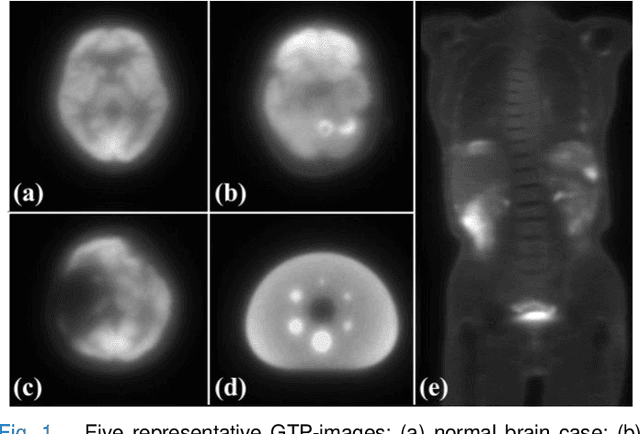
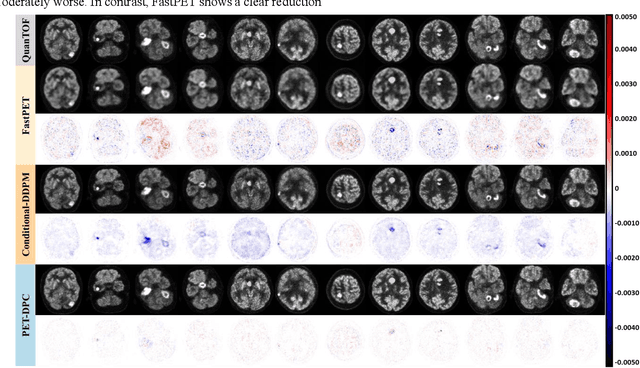
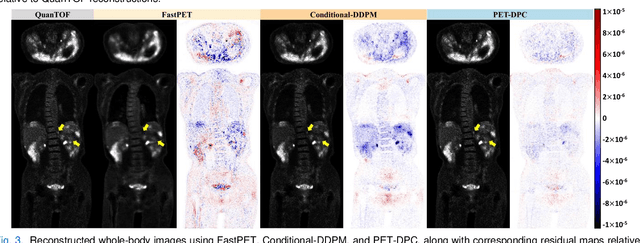
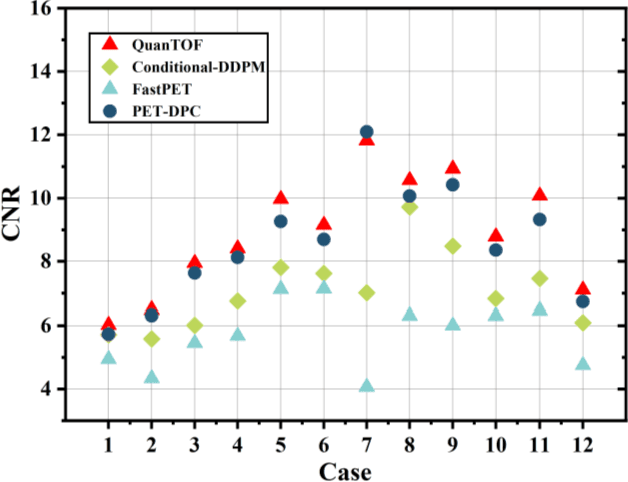
Abstract:Deep learning-based reconstruction of positron emission tomography(PET) data has gained increasing attention in recent years. While these methods achieve fast reconstruction,concerns remain regarding quantitative accuracy and the presence of artifacts,stemming from limited model interpretability,data driven dependence, and overfitting risks.These challenges have hindered clinical adoption.To address them,we propose a conditional diffusion model with posterior physical correction (PET-DPC) for PET image reconstruction. An innovative normalization procedure generates the input Geometric TOF Probabilistic Image (GTP-image),while physical information is incorporated during the diffusion sampling process to perform posterior scatter,attenuation,and random corrections. The model was trained and validated on 300 brain and 50 whole-body PET datasets,a physical phantom,and 20 simulated brain datasets. PET-DPC produced reconstructions closely aligned with fully corrected OSEM images,outperforming end-to-end deep learning models in quantitative metrics and,in some cases, surpassing traditional iterative methods. The model also generalized well to out-of-distribution(OOD) data. Compared to iterative methods,PET-DPC reduced reconstruction time by 50% for brain scans and 85% for whole-body scans. Ablation studies confirmed the critical role of posterior correction in implementing scatter and attenuation corrections,enhancing reconstruction accuracy. Experiments with physical phantoms further demonstrated PET-DPC's ability to preserve background uniformity and accurately reproduce tumor-to-background intensity ratios. Overall,these results highlight PET-DPC as a promising approach for rapid, quantitatively accurate PET reconstruction,with strong potential to improve clinical imaging workflows.
LLM-Guided Taxonomy and Hierarchical Uncertainty for 3D Point CLoud Active Learning
May 25, 2025Abstract:We present a novel active learning framework for 3D point cloud semantic segmentation that, for the first time, integrates large language models (LLMs) to construct hierarchical label structures and guide uncertainty-based sample selection. Unlike prior methods that treat labels as flat and independent, our approach leverages LLM prompting to automatically generate multi-level semantic taxonomies and introduces a recursive uncertainty projection mechanism that propagates uncertainty across hierarchy levels. This enables spatially diverse, label-aware point selection that respects the inherent semantic structure of 3D scenes. Experiments on S3DIS and ScanNet v2 show that our method achieves up to 4% mIoU improvement under extremely low annotation budgets (e.g., 0.02%), substantially outperforming existing baselines. Our results highlight the untapped potential of LLMs as knowledge priors in 3D vision and establish hierarchical uncertainty modeling as a powerful paradigm for efficient point cloud annotation.
Seek in the Dark: Reasoning via Test-Time Instance-Level Policy Gradient in Latent Space
May 19, 2025Abstract:Reasoning ability, a core component of human intelligence, continues to pose a significant challenge for Large Language Models (LLMs) in the pursuit of AGI. Although model performance has improved under the training scaling law, significant challenges remain, particularly with respect to training algorithms, such as catastrophic forgetting, and the limited availability of novel training data. As an alternative, test-time scaling enhances reasoning performance by increasing test-time computation without parameter updating. Unlike prior methods in this paradigm focused on token space, we propose leveraging latent space for more effective reasoning and better adherence to the test-time scaling law. We introduce LatentSeek, a novel framework that enhances LLM reasoning through Test-Time Instance-level Adaptation (TTIA) within the model's latent space. Specifically, LatentSeek leverages policy gradient to iteratively update latent representations, guided by self-generated reward signals. LatentSeek is evaluated on a range of reasoning benchmarks, including GSM8K, MATH-500, and AIME2024, across multiple LLM architectures. Results show that LatentSeek consistently outperforms strong baselines, such as Chain-of-Thought prompting and fine-tuning-based methods. Furthermore, our analysis demonstrates that LatentSeek is highly efficient, typically converging within a few iterations for problems of average complexity, while also benefiting from additional iterations, thereby highlighting the potential of test-time scaling in the latent space. These findings position LatentSeek as a lightweight, scalable, and effective solution for enhancing the reasoning capabilities of LLMs.
FreeInsert: Disentangled Text-Guided Object Insertion in 3D Gaussian Scene without Spatial Priors
May 02, 2025Abstract:Text-driven object insertion in 3D scenes is an emerging task that enables intuitive scene editing through natural language. However, existing 2D editing-based methods often rely on spatial priors such as 2D masks or 3D bounding boxes, and they struggle to ensure consistency of the inserted object. These limitations hinder flexibility and scalability in real-world applications. In this paper, we propose FreeInsert, a novel framework that leverages foundation models including MLLMs, LGMs, and diffusion models to disentangle object generation from spatial placement. This enables unsupervised and flexible object insertion in 3D scenes without spatial priors. FreeInsert starts with an MLLM-based parser that extracts structured semantics, including object types, spatial relationships, and attachment regions, from user instructions. These semantics guide both the reconstruction of the inserted object for 3D consistency and the learning of its degrees of freedom. We leverage the spatial reasoning capabilities of MLLMs to initialize object pose and scale. A hierarchical, spatially aware refinement stage further integrates spatial semantics and MLLM-inferred priors to enhance placement. Finally, the appearance of the object is improved using the inserted-object image to enhance visual fidelity. Experimental results demonstrate that FreeInsert achieves semantically coherent, spatially precise, and visually realistic 3D insertions without relying on spatial priors, offering a user-friendly and flexible editing experience.
Efficient Collaborative Navigation through Perception Fusion for Multi-Robots in Unknown Environments
Nov 02, 2024Abstract:For tasks conducted in unknown environments with efficiency requirements, real-time navigation of multi-robot systems remains challenging due to unfamiliarity with surroundings.In this paper, we propose a novel multi-robot collaborative planning method that leverages the perception of different robots to intelligently select search directions and improve planning efficiency. Specifically, a foundational planner is employed to ensure reliable exploration towards targets in unknown environments and we introduce Graph Attention Architecture with Information Gain Weight(GIWT) to synthesizes the information from the target robot and its teammates to facilitate effective navigation around obstacles.In GIWT, after regionally encoding the relative positions of the robots along with their perceptual features, we compute the shared attention scores and incorporate the information gain obtained from neighboring robots as a supplementary weight. We design a corresponding expert data generation scheme to simulate real-world decision-making conditions for network training. Simulation experiments and real robot tests demonstrates that the proposed method significantly improves efficiency and enables collaborative planning for multiple robots. Our method achieves approximately 82% accuracy on the expert dataset and reduces the average path length by about 8% and 6% across two types of tasks compared to the fundamental planner in ROS tests, and a path length reduction of over 6% in real-world experiments.
Cycle-Constrained Adversarial Denoising Convolutional Network for PET Image Denoising: Multi-Dimensional Validation on Large Datasets with Reader Study and Real Low-Dose Data
Oct 31, 2024
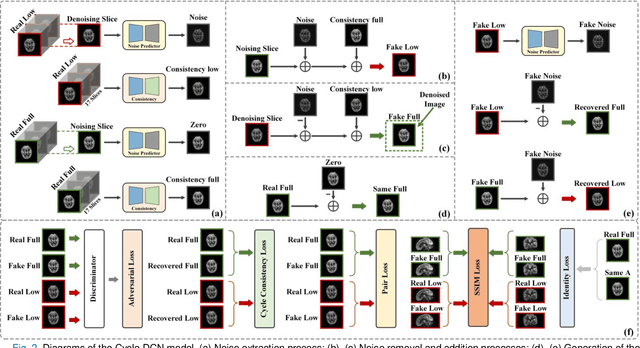
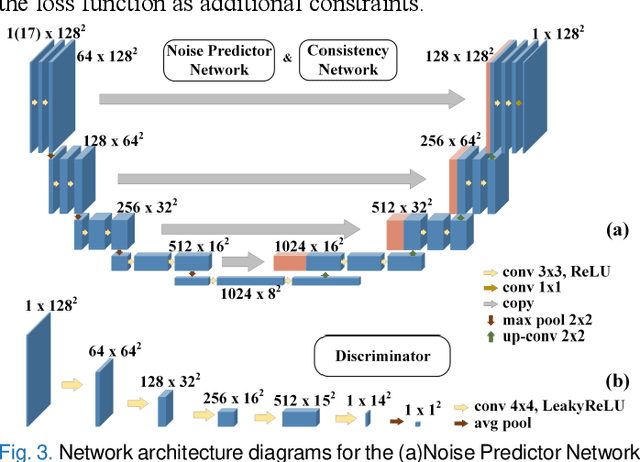
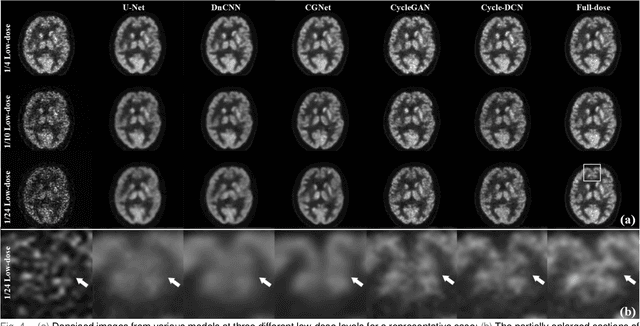
Abstract:Positron emission tomography (PET) is a critical tool for diagnosing tumors and neurological disorders but poses radiation risks to patients, particularly to sensitive populations. While reducing injected radiation dose mitigates this risk, it often compromises image quality. To reconstruct full-dose-quality images from low-dose scans, we propose a Cycle-constrained Adversarial Denoising Convolutional Network (Cycle-DCN). This model integrates a noise predictor, two discriminators, and a consistency network, and is optimized using a combination of supervised loss, adversarial loss, cycle consistency loss, identity loss, and neighboring Structural Similarity Index (SSIM) loss. Experiments were conducted on a large dataset consisting of raw PET brain data from 1,224 patients, acquired using a Siemens Biograph Vision PET/CT scanner. Each patient underwent a 120-seconds brain scan. To simulate low-dose PET conditions, images were reconstructed from shortened scan durations of 30, 12, and 5 seconds, corresponding to 1/4, 1/10, and 1/24 of the full-dose acquisition, respectively, using a custom-developed GPU-based image reconstruction software. The results show that Cycle-DCN significantly improves average Peak Signal-to-Noise Ratio (PSNR), SSIM, and Normalized Root Mean Square Error (NRMSE) across three dose levels, with improvements of up to 56%, 35%, and 71%, respectively. Additionally, it achieves contrast-to-noise ratio (CNR) and Edge Preservation Index (EPI) values that closely align with full-dose images, effectively preserving image details, tumor shape, and contrast, while resolving issues with blurred edges. The results of reader studies indicated that the images restored by Cycle-DCN consistently received the highest ratings from nuclear medicine physicians, highlighting their strong clinical relevance.
A Social Force Model for Multi-Agent Systems With Application to Robots Traversal in Cluttered Environments
Sep 16, 2024



Abstract:This letter presents a model to address the collaborative effects in multi-agent systems from the perspective of microscopic mechanism. The model utilizes distributed control for robot swarms in traversal applications. Inspired by pedestrian planning dynamics, the model employs three types of forces to regulate the behavior of agents: intrinsic propulsion, interaction among agents, and repulsion from obstacles. These forces are able to balance the convergence, divergence and avoidance effects among agents. Additionally, we present a planning and decision method based on resultant forces to enable real-world deployment of the model. Experimental results demonstrate the effectiveness on system path optimization in unknown cluttered environments. The sensor data is swiftly digital filtered and the data transmitted is significantly compressed. Consequently, the model has low computation costs and minimal communication loads, thereby promoting environmental adaptability and system scalability.
Unveiling the Unseen: Exploring Whitebox Membership Inference through the Lens of Explainability
Jul 01, 2024


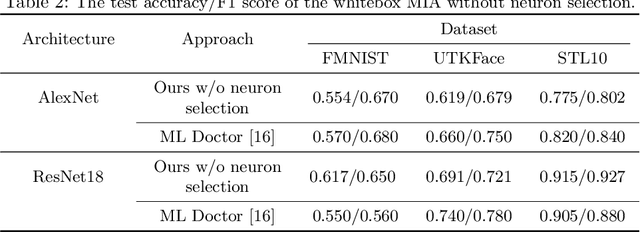
Abstract:The increasing prominence of deep learning applications and reliance on personalized data underscore the urgent need to address privacy vulnerabilities, particularly Membership Inference Attacks (MIAs). Despite numerous MIA studies, significant knowledge gaps persist, particularly regarding the impact of hidden features (in isolation) on attack efficacy and insufficient justification for the root causes of attacks based on raw data features. In this paper, we aim to address these knowledge gaps by first exploring statistical approaches to identify the most informative neurons and quantifying the significance of the hidden activations from the selected neurons on attack accuracy, in isolation and combination. Additionally, we propose an attack-driven explainable framework by integrating the target and attack models to identify the most influential features of raw data that lead to successful membership inference attacks. Our proposed MIA shows an improvement of up to 26% on state-of-the-art MIA.
Highly Efficient Observation Process based on FFT Filtering for Robot Swarm Collaborative Navigation in Unknown Environments
May 13, 2024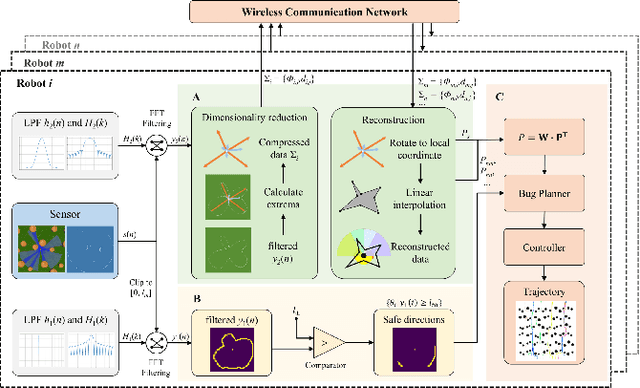
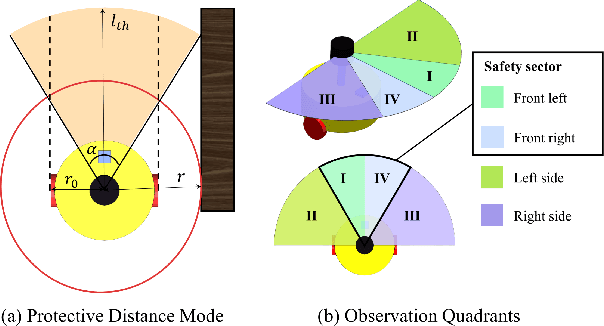
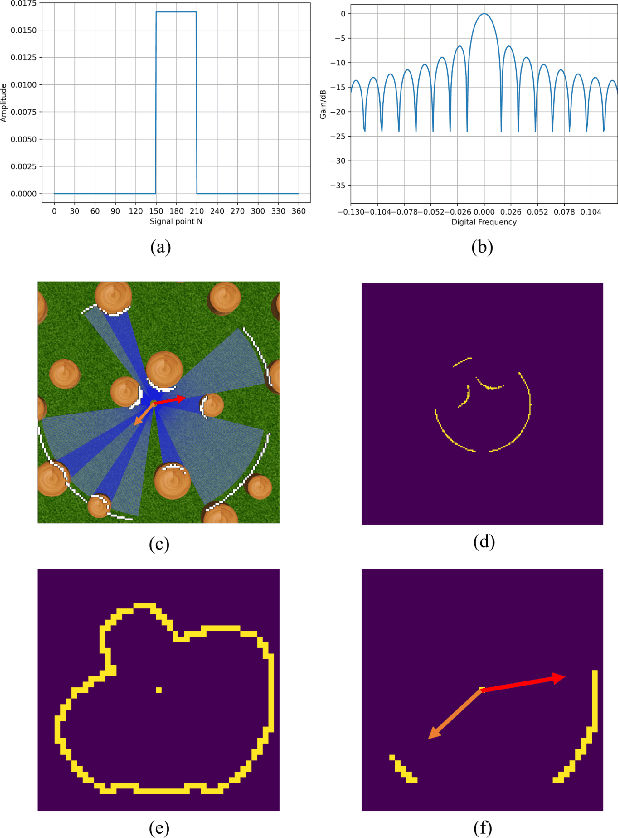

Abstract:Collaborative path planning for robot swarms in complex, unknown environments without external positioning is a challenging problem. This requires robots to find safe directions based on real-time environmental observations, and to efficiently transfer and fuse these observations within the swarm. This study presents a filtering method based on Fast Fourier Transform (FFT) to address these two issues. We treat sensors' environmental observations as a digital sampling process. Then, we design two different types of filters for safe direction extraction, as well as for the compression and reconstruction of environmental data. The reconstructed data is mapped to probabilistic domain, achieving efficient fusion of swarm observations and planning decision. The computation time is only on the order of microseconds, and the transmission data in communication systems is in bit-level. The performance of our algorithm in sensor data processing was validated in real world experiments, and the effectiveness in swarm path optimization was demonstrated through extensive simulations.
 Add to Chrome
Add to Chrome Add to Firefox
Add to Firefox Add to Edge
Add to Edge